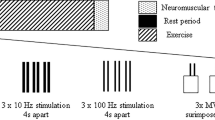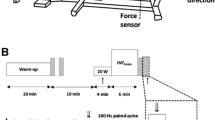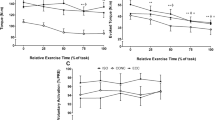Abstract
The present study compared neuromuscular fatigue of the knee extensor muscles following highly variable versus constant power output cycling. Ten subjects performed two 33-min cycling trials of the same average power output, in a random order. Cycling exercise was performed either at constant (CST) power output, corresponding to 70% of the maximal aerobic power (MAP), or at variable (VAR) power output with alternating high (200, 150 and 100% of MAP during 10, 15 and 20 s, respectively) and moderate (50% of MAP) power output periods. Neuromuscular tests were performed before and immediately after the two trials. Heart rate (HR) was measured during exercise and blood lactate concentration ([La]) at the end of both trials. Reductions in maximal voluntary contraction torque, voluntary activation level and peak doublet were significantly greater after VAR than after CST. HR and [La] were significantly higher during VAR than during CST. Cycling at a varying power output in comparison to constant power resulted in additional muscular fatigue that may be explained by greater anaerobic contribution and muscle solicitation during the highly variable power output protocol.




Similar content being viewed by others
References
Aktinson G, Brunskill A (2000) Pacing strategy during a cycling time trial with simulated headwinds and tailwinds. Ergonomics 43(10):1449–1460
Ball-Burnett M, Green HJ, Houston ME (1991) Energy metabolism in human slow and fast twitch fibres during prolonged cycle exercise. J Physiol 437:257–267
Behm DG, Saint-Pierre D, Perez D (1996) Muscle inactivation: assessment of interpolated twitch technique. J Appl Physiol 81(5):2267–2273
Bentley DJ, Smith PA, Davie AJ, Zhou S (2000) Muscle activation of the knee extensors following high intensity endurance exercise in cyclists. Eur J Appl Physiol 81(4):297–302
Bernard T, Vercruyssen F, Mazure C, Gorce P, Hausswirth C, Brisswalter J (2007) Constant versus variable-intensity during cycling: effects on subsequent running performance. Eur J Appl Physiol 99:103–111
Bongiovanni LG, Hagbarth K (1990) Tonic vibration reflexes elicited during fatigue from maximal voluntary contractions in man. J Physiol 423:1–14
Booth J, Mc Kenna MJ, Ruell PA, Gwinn TH, Davis GM, Thompson MW, Harmer AR, Hunter SK, Sutton JR (1997) Impaired calcium pump function does not slow relaxation in human skeletal muscle after prolonged exercise. J Appl Physiol 83(2):511–521
Borg G (1970) Perceived exertion as an indicator of somatic stress. Scand J Rehabil Med 2(2):92–98
Davies CT, White MJ (1982) Muscle weakness following dynamic exercise in humans. J Appl Physiol 53(1):236–241
Davis JM, Bailey S (1997) Possible mechanisms of central nervous system fatigue during exercise. Med Sci Sports Exerc 29(1):45–57
Ebert TR, Martin D, McDonald W, Victor J, Plummer J, Withers RT (2005) Power output during women’s World Cup road cycle racing. Eur J Appl Physiol 95:529–536
Gandevia SC (1998) Neural control in human muscle fatigue: changes in muscle afferents, motoneurones and motor cortical drive. Acta Physiol Scand 162(3):275–283
Gandevia SC (2001) Spinal and supraspinal factors in human muscle fatigue. Physiol Rev 81(4):1725–1789
Garland SJ, McComas A (1990) Reflex inhibition of human soleus muscle during fatigue. J Physiol 429:17–27
Juel C (1998) Skeletal muscle Na+/H+ exchange in rats: pH dependency and the effect of training. Acta Physiol Scand 164(2):135–140
Kay D, Marino F, Cannon J, St Clair Gibson A, Lambert MI, Noakes TD, (2001) Evidence for neuromuscular fatigue during high-intensity cycling in warm, humid conditions. Eur J Appl Physiol 84(1–2):115–121
Laforgia J, Whiters R, Shipp NJ, Gore CJ (1997) Comparison of energy expenditure elevations after submaximal and supramaximal running. J Appl Physiol 82(2):661–666
Lepers R, Hausswirth C, Maffiuletti N, Brisswalter J, Van Hoecke J (2000) Evidence of neuromuscular fatigue after prolonged cycling exercise. Med Sci Sports Exerc 32(11):1880–1886
Lepers R, Millet G, Maffiuletti NA (2001a) Effect of cycling cadence on contractile and neural properties of knee extensors. Med Sci Sports Exerc 33(11):1882–1888
Lepers R, Millet G, Maffiuletti NA, Hausswirth C, Brisswalter J (2001b) Effect of pedalling rates on physiological response during endurance cycling. Eur J Appl Physiol 85(3–4):392–395
Lepers R, Maffiuletti NA, Rochette L, Brugniaux J, Millet GY (2002) Neuromuscular fatigue during a long-duration cycling exercise. J Appl Physiol 92(4):1487–1493
Lepers R, Theurel J, Hausswirth C, Bernard T (2008) Neuromuscular fatigue following constant versus variable-intensity endurance cycling in triathletes. J Sci Med Sport. doi:10.1016/j.jsams.2007.03.001. (in press)
Liedl MA, Swain D, Branch JD (1999) Physiological effects of constant versus variable power during endurance cycling. Med Sci Sports Exerc 31(10):1472–1477
Martin DT, McLean B, Trewin C, Lee H, Victor J, Hahn AG (2001) Physiological characteristics of nationally competitive female road cyclists and demands of competition. Sports Med 31(7):469–477
Merton PA (1954) Voluntary strength and fatigue. J Physiol 123(3):553–564
Metzger JM, Moss R (1990) pH modulation of the kinetics of a Ca2(+)-sensitive cross-bridge state transition in mammalian single skeletal muscle fibres. J Physiol 428:751–764
Miller M, Downham D, Lexell J (1999) Superimposed single impulse and pulse train electrical stimulation: A quantitative assessment during submaximal isometric knee extension in young, healthy men. Muscle Nerve 22(8):1038–1046
Millet GY, Lepers R, Maffiuletti NA, Babault N, Martin V, Lattier G (2002) Alterations of neuromuscular function after an ultramarathon. J Appl Physiol 92(2):486–492
Palmer GS, Borghouts LB, Noakes TD, Hawley JA (1999) Metabolic and performance responses to constant-load vs. variable-intensity exercise in trained cyclists. J Appl Physiol 87(3):1186–1196
Palmer GS, Noakes T, Hawley JA (1997) Effects of steady-state versus stochastic exercise on subsequent cycling performance. Med Sci Sports Exerc 29(5):684–687
Pitsiladis YP, Strachan A, Davidson I, Maughan RJ (2002) Hyperprolactinaemia during prolonged exercise in the heat: evidence for a centrally mediated component of fatigue in trained cyclists. Exp Physiol 87(2):215–226
Place N, Maffiuletti N, Martin A, Lepers R (2007) Assessment of the reliability of central and peripheral fatigue after sustained maximal voluntary contraction of the quadriceps muscle. Muscle Nerve 35(4):486–495
Rassier DE, Macintosh B (2000) Coexistence of potentiation and fatigue in skeletal muscle. Braz J Med Biol Res 33(5):499–508
St Clair Gibson A, Schabort EJ, Noakes TD (2001) Reduced neuromuscular activity and force generation during prolonged cycling. Am J Physiol Regul Integr Comp Physiol 281(1):R187–R196
Strojnik V, Komi PV (1998) Neuromuscular fatigue after maximal stretch-shortening cycle exercise. J Appl Physiol 84(1):344–350
Swain DP (1997) A model for optimizing cycling performance by varying power on hills and in wind. Med Sci Sports Exerc 29(8):1104–1108
Vogt S, Schumacher YO, Roecker K, Dickhuth HH, Schoberer U, Schmid A, Heinrich L, (2007) Power output during the Tour de France. Int J Sports Med 28(9):756–761
Westerblad H, Duty S, Allen DG (1993) Intracellular calcium concentration during low-frequency fatigue in isolated single fibers of mouse skeletal muscle. J Appl Physiol 75(1):382–388
Wilson WM, Maughan RJ (1992) Evidence for a possible role of 5-hydroxytryptamine in the genesis of fatigue in man: administration of paroxetine, a 5-HT re-uptake inhibitor, reduces the capacity to perform prolonged exercise. Exp Physiol 77(6):921–924
Author information
Authors and Affiliations
Corresponding author
Rights and permissions
About this article
Cite this article
Theurel, J., Lepers, R. Neuromuscular fatigue is greater following highly variable versus constant intensity endurance cycling. Eur J Appl Physiol 103, 461–468 (2008). https://doi.org/10.1007/s00421-008-0738-2
Accepted:
Published:
Issue Date:
DOI: https://doi.org/10.1007/s00421-008-0738-2




